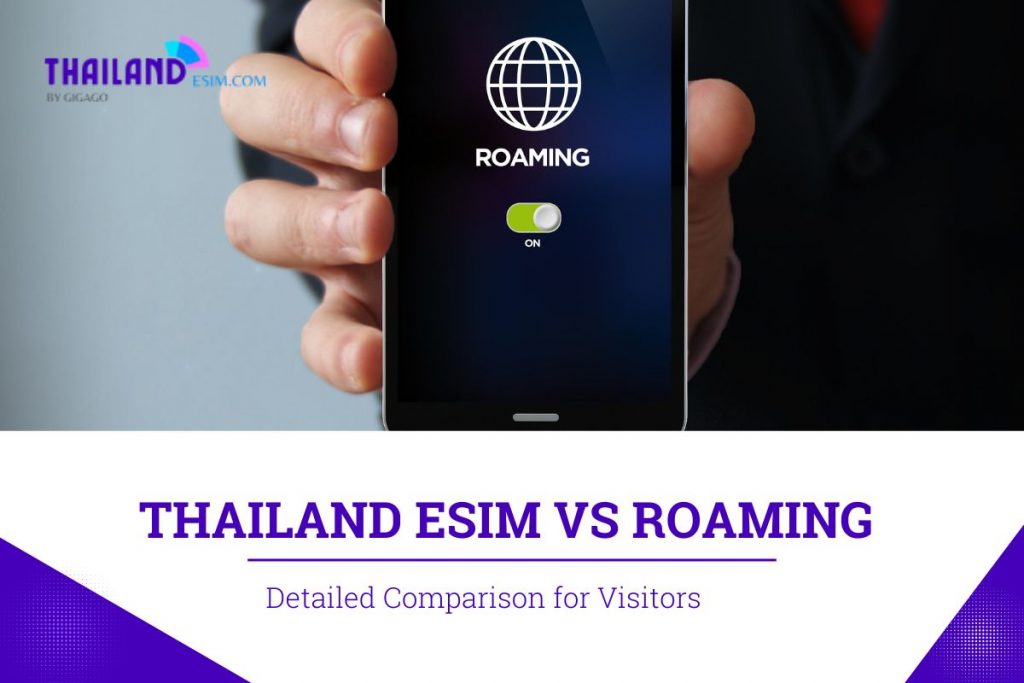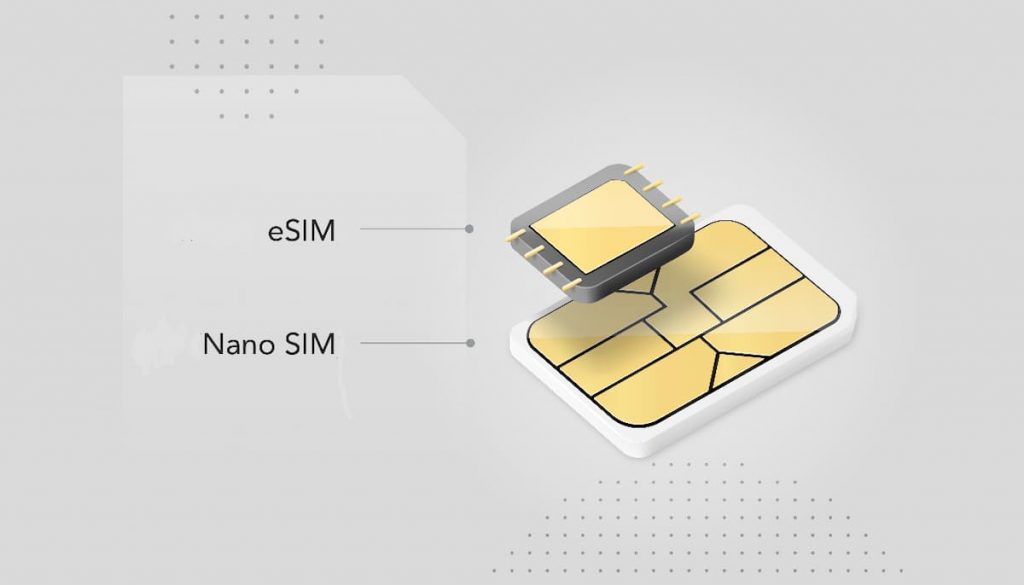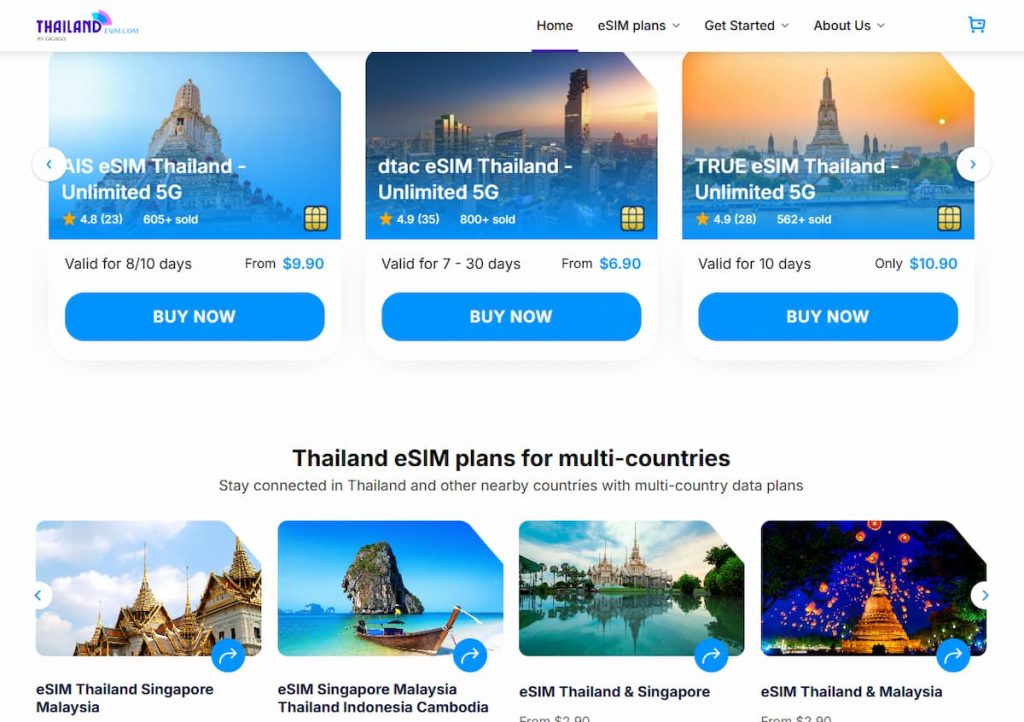Heading to Thailand and tired of worrying about phone connectivity? You have two main options: roaming and Thailand eSIM. Your choice comes down to priorities: maximum convenience versus cost savings, instant connectivity versus a bit of preparation, and familiar billing versus learning something new. Let’s explore two main connectivity options with our guide!

Table of Contents
Can I use eSIM in Thailand?
Thailand fully supports eSIM technology across all major carriers, allowing travelers to stay connected seamlessly. The country’s eSIM infrastructure offers convenience and flexibility, revolutionizing how visitors access mobile internet during their trips.
An eSIM allows you to download and activate a mobile plan from a provider without needing a physical SIM. You can typically choose from plans that are usually prepaid, offering you a set amount of data, texts, and calls.

Pros and cons of Thailand eSIM
| Aspect | Benefits | Drawbacks |
| Setup | Quick activation without physical cards | Requires technical configuration that may confuse some users |
| Hardware | Eliminates the need for additional equipment | Limited to newer smartphones with eSIM capability |
| Pricing | More economical for extended visits, no equipment rental | Setup charges apply, plan changes can be difficult |
| Usability | Compact solution, maintains original phone number | Cannot be shared among multiple users |
| Connection | Direct carrier access with 5G compatibility | May increase battery consumption on certain devices |
| Adaptability | Supports multiple carrier profiles, no physical returns | Switching between carriers proves challenging, and sharing restrictions apply |
What Is Roaming in Thailand?
Roaming in Thailand means using your home country’s mobile carrier while traveling, allowing your phone to connect to Thai mobile networks through partnerships with local operators like AIS, TrueMove H, or dtac. Your home carrier handles all billing and charges you international roaming rates for calls, texts, and data usage.
Pros of roaming in Thailand
- Zero Setup Required: Your phone works immediately upon arrival with no configuration needed. Simply turn on your device, and you’re connected to Thai networks within minutes of landing.
- Seamless Communication: People can reach you on your regular number without international dialing codes. Business contacts and family can call or text as if you never left home.
- Automatic Network Switching: Your phone connects to the strongest available partner network automatically as you travel across Thailand, ensuring consistent coverage in cities and tourist areas.
Cons of roaming in Thailand
- High Costs: Roaming rates can be 10-50 times more expensive than local rates, with data charges reaching $10-15 per day even with travel packages from major carriers.
- Bill Shock Risk: Unexpected charges can accumulate quickly, especially with automatic app updates, cloud backups, or streaming services running in the background.
- Limited Data Allowances: Most roaming packages include modest data limits that may not cover heavy usage like navigation, photo uploads, or video calls throughout your trip.
- Slower Speeds: Roaming connections often provide reduced data speeds compared to local SIM cards or eSIMs, affecting your browsing and app performance.
✨Read also: Data Roaming in Thailand: #1 Helpful Guide for Travelers
Thailand eSIM vs Roaming: Which one is better for visitors
Both Roaming and eSIM are excellent solutions for staying connected in Thailand. Your choice depends on your travel habits and preferences.
eSIM – Best for Most Travelers
- Affordable: Prepaid plans with no surprise charges
- Instant setup: Activate via QR code before or upon arrival
- Local network access: Faster speeds and better coverage than roaming
- Great for longer stays or heavy data use
✨For a reliable connection, consider using Thailand eSIM from Thailandesim.com, which offers diverse eSIM plans at a cheap price.

Roaming – Best for Short, Emergency Use
- Convenient: No setup needed if enabled with your carrier
- Expensive: Often high per-MB rates unless part of a roaming bundle
- Unpredictable charges: Easy to exceed limits and incur extra fees
- Best for short trips or travelers with built-in roaming packages
Conclusion
For most visitors to Thailand, eSIM is the smarter choice; it’s affordable, easy to activate, and gives you access to reliable local networks without surprise charges. While roaming may be convenient for quick trips or emergencies, its high cost and limited control make it less ideal for regular travel. If you want seamless, cost-effective connectivity during your stay, choosing an eSIM is the way to go